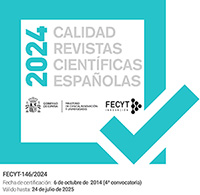La historia del papel en la Castilla medieval: el archivo de la Catedral y la judería de Burgos en el siglo XIV
DOI:
https://doi.org/10.5944/etfiii.27.2014.12652Palabras clave:
Historia del papel, Archivo Catedral de Burgos, siglo XIV, judería, comercio Burgos-sur de Francia, History of paper, Burgos Cathedral Archive, Fourteenth century, Medieval Jewish Quarter of Burgos, Trade between Burgos and the south of FranceResumen
El presente artículo pretende ser una primera contribución al conocimiento de la fabricación, comercialización y uso del papel como materia scriptoria en la Castilla bajomedieval. El estudio del caso burgalés a través de la abundante y variada documentación de su archivo catedralicio ha permito identificar la importancia de su judería como centro productor de papel «hispano-árabe». Aunque la mayoría de la documentación medieval que se conserva está escrita en pergamino, paulatinamente desde fines del siglo XIII y en el siglo XIV el papel se convierte en el soporte principal. Al mismo tiempo, se utilizó otro tipo de papel, importado desde el sur de Francia, que testimonia las estrechas relaciones comerciales y políticas de ambos reinos.
This article is an initial attempt to study the manufacturing, commercialization and use of paper as a material of support for script in Late Medieval Castile. Through abundant and variegated records in the Cathedral archive, the Burgos case study has enabled us to identify the importance of its Jewish Quarter as a producer of the type of paper know as «Hispano-Arabic». Even if the majority of medieval documents are written on parchment, gradually from the end of the thirteenth century and especially from the fourteenth century on, paper becomes the main material on which they are written. Furthermore, a different type of paper from the south of France was also used, which testifies to the close political and trade relations which existed between the two kingdoms.
Descargas
Descargas
Publicado
Cómo citar
Número
Sección
Licencia
Los autores que publican en esta revista están de acuerdo con los siguientes términos:
- Los autores conservan los derechos de autor (copyright) de las obras publicadas y garantizan a la revista el derecho de ser la primera publicación del trabajo al igual que permiten la reutilización del mismo bajo la licencia de uso indicada en el punto 2.
- Las obras se publican en la edición electrónica de la revista bajo una licencia Creative Commons Reconocimiento-NoComercial 4.0 Internacional, que permite a otros compartir el trabajo con un reconocimiento de la autoría del trabajo y de la publicación inicial en esta revista. Se pueden copiar, usar, difundir, transmitir y exponer públicamente, siempre que: i) se cite la autoría y la fuente original de su publicación (revista, editorial y URL de la obra); ii) no se usen para fines comerciales.
- Se permite y se anima a los autores a difundir electrónicamente las versiones pre-print (versión antes de ser evaluada) y/o post-print (versión evaluada y aceptada para su publicación) de sus obras antes de su publicación, ya que favorece su circulación y difusión más temprana y con ello un posible aumento en su citación y alcance entre la comunidad académica (por ejemplo, en repositorios institucionales o en su propio sitio web). Color RoMEO: verde. (Véase The Effect of Open Access) (en inglés).
Authors who publish in this journal agree to the following terms:
- Authors retain copyright and grant the journal right of the first publication with the work simultaneously licensed under a Attribution-NonCommercial-NoDerivatives 4.0 International, that allows others to share the work with an acknowledgement of the work's authorship and initial publication in this journal.
- Authors are able to enter into separate, additional contractual arrangements for the non-exclusive distribution of the journal's published version of the work (e.g., post it to an institutional repository or publish it in a book), with an acknowledgement of its initial publication in this journal.
- Authors are permitted and encouraged to post their work online (e.g., in institutional repositories or on their website) prior to and during the submission process, as it can lead to productive exchanges, as well as to earlier and greater citation of the published work (See The Effect of Open Access).








